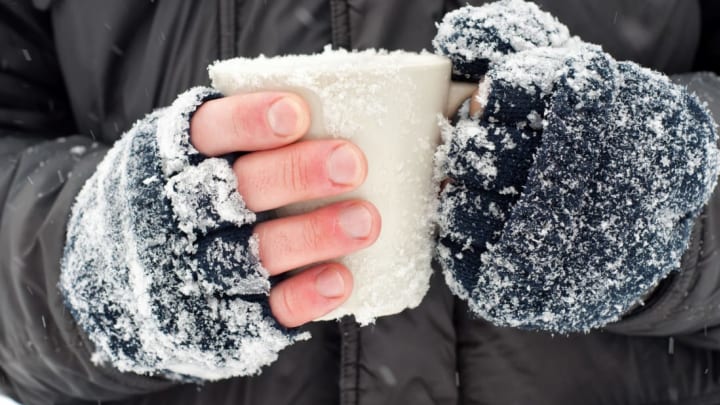A healthy portion of the United States is currently suffering the effects of the polar vortex, a weather phenomenon that has seen temperatures plummet to as low as -26°F in Chicago. Factor in wind speed and anyone caught outside could have to endure wind chills hitting -60°F. For contrast, the Popsicles in your freezer are likely chilling out at a mere 0°F.
These extreme conditions have some real and alarming consequences. In Madison, Wisconsin, seven people were treated Wednesday night for frostbite symptoms, which result from the body rerouting blood and oxygen from extremities to major organs in response to frigid temperatures. As blood vessels narrow, tiny ice crystals form in the skin. The skin freezes, turning blue, firm, or waxy in appearance. Blisters can form. It can also feel numb or tingle. Left untreated, permanent nerve damage or gangrene can result, possibly requiring amputation of the affected body parts.
The risk of developing frostbite depends on duration of exposure and wind chill. The lower the temperature, the less time it takes to develop complications. At a wind chill of -22°F, it would take 31 minutes of exposure. At -45°F, you've got six minutes. Fingers, toes, noses, cheeks, and ears are the sites most commonly affected.
Frostbite stages depend on how deep it's penetrated the skin. Simple frostbite, or frostnip, is superficial, with some redness and subsequent numbness. Warm skin is an indication the frostbite is more advanced. Deep frostbite, which can reach subcutaneous tissue, could mean tissue death.
If you begin to notice symptoms of frostbite, follow your instincts and seek shelter immediately. Once you're inside, resist the urge to rub the affected skin, run it under hot water, or apply a hot compress: Because of the numbness, you won't be able to tell if you're burning yourself. Instead, use warm water and your own body heat—like tucking fingers into your armpits—until you can be seen by a doctor. (Some people may benefit from home treatment until the skin returns to its normal color. If you're unsure, it's best to seek medical advice.)
Of potentially greater concern is hypothermia, a condition in which people lose too much body heat, often brought on by the combination of low temperatures and wet clothing. As the body temperature plummets, people can become disoriented or even lose consciousness. Hypothermia requires medical attention. If the hypothermic person is awake, drinking warm beverages and getting wrapped in warm blankets may help until they can be seen by a physician.
Naturally, the best prevention for both frostbite and hypothermia is avoidance. Stay indoors, preferably until spring.
[h/t The New York Times]
